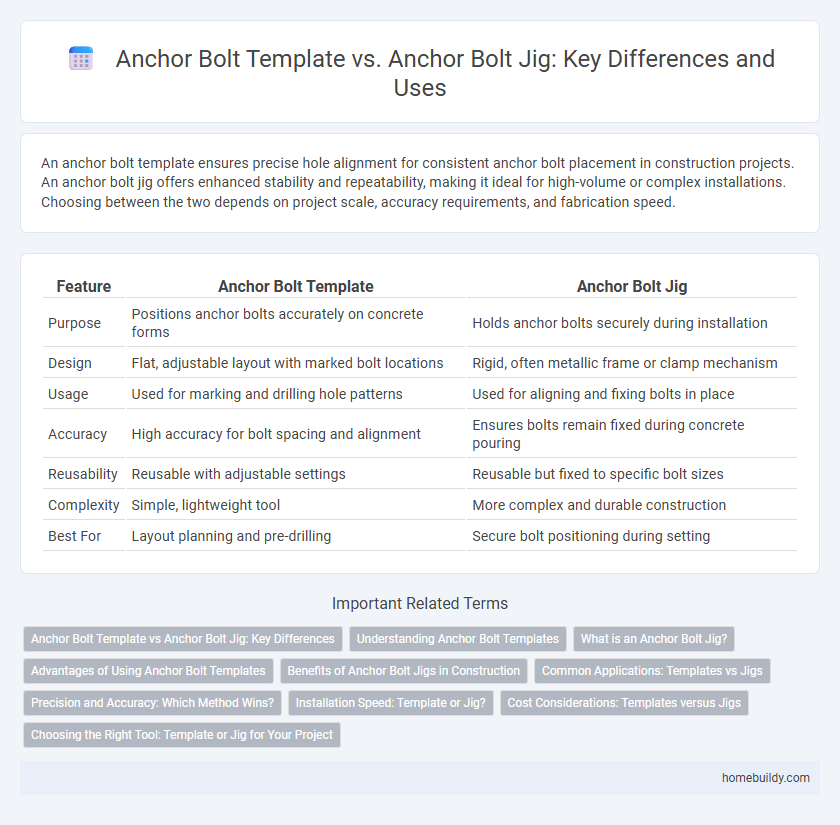An anchor bolt template ensures precise hole alignment for consistent anchor bolt placement in construction projects. An anchor bolt jig offers enhanced stability and repeatability, making it ideal for high-volume or complex installations. Choosing between the two depends on project scale, accuracy requirements, and fabrication speed.
Table of Comparison
| Feature | Anchor Bolt Template | Anchor Bolt Jig |
|---|---|---|
| Purpose | Positions anchor bolts accurately on concrete forms | Holds anchor bolts securely during installation |
| Design | Flat, adjustable layout with marked bolt locations | Rigid, often metallic frame or clamp mechanism |
| Usage | Used for marking and drilling hole patterns | Used for aligning and fixing bolts in place |
| Accuracy | High accuracy for bolt spacing and alignment | Ensures bolts remain fixed during concrete pouring |
| Reusability | Reusable with adjustable settings | Reusable but fixed to specific bolt sizes |
| Complexity | Simple, lightweight tool | More complex and durable construction |
| Best For | Layout planning and pre-drilling | Secure bolt positioning during setting |
Anchor Bolt Template vs Anchor Bolt Jig: Key Differences
Anchor bolt templates are typically flat, pre-marked tools designed for positioning multiple anchor bolts accurately in concrete, ensuring uniform spacing and alignment. Anchor bolt jigs, however, are more robust fixtures that hold and guide the bolts during installation, providing greater stability and precision in complex or heavy-duty projects. The key differences lie in their function and design: templates serve as guides for layout while jigs offer support and consistent placement throughout the anchor bolt installation process.
Understanding Anchor Bolt Templates
Anchor bolt templates provide precise guidance for drilling anchor bolt holes, ensuring consistent alignment and spacing during concrete formwork. Unlike anchor bolt jigs, which are reusable fixtures holding bolts in place, templates serve as reusable or disposable patterns for marking exact bolt locations before installation. Understanding anchor bolt templates is crucial for achieving accurate bolt placement, reducing installation errors, and optimizing structural integrity.
What is an Anchor Bolt Jig?
An anchor bolt jig is a precision tool used to position anchor bolts accurately during concrete foundation work, ensuring consistent placement and alignment according to design specifications. Unlike an anchor bolt template, which is typically a flat guide or pattern for marking bolt locations, the jig provides adjustable supports and fixtures to hold bolts securely in place while concrete is poured. This enhances structural integrity and reduces installation errors in construction projects requiring exact bolt positioning.
Advantages of Using Anchor Bolt Templates
Anchor bolt templates provide precise positioning and alignment of anchor bolts, significantly reducing installation errors and rework. They enhance efficiency on construction sites by speeding up the placement process and ensuring consistent spacing, which is critical for structural integrity. Using templates also improves safety by minimizing the need for manual measurements and adjustments during anchor bolt installation.
Benefits of Anchor Bolt Jigs in Construction
Anchor bolt jigs provide precise alignment and consistent positioning of anchor bolts, reducing installation errors and enhancing structural stability in construction projects. The use of anchor bolt jigs accelerates the setup process, minimizing labor time and ensuring repeatable accuracy compared to traditional anchor bolt templates. Improved efficiency and reliability from anchor bolt jigs contribute to higher overall quality and safety in foundation and framing work.
Common Applications: Templates vs Jigs
Anchor bolt templates are widely used in construction projects for precise layout and positioning of bolts before concrete pouring, ensuring consistent spacing and alignment in foundation slabs. Anchor bolt jigs, on the other hand, serve as reusable guides that hold bolts firmly in place during installation, offering enhanced accuracy for complex or repetitive assemblies like steel column bases or heavy equipment anchoring. Choosing between templates and jigs depends on project scale and complexity, with templates favored for large-scale concrete work and jigs preferred for precision tasks requiring repeatability.
Precision and Accuracy: Which Method Wins?
Anchor bolt templates offer consistent positioning and standardized hole alignment, ensuring high repeatability in bolt placement across multiple installations. Anchor bolt jigs provide superior precision by securely holding each bolt in a fixed position during installation, minimizing movement and increasing accuracy. For critical applications demanding exact alignment and minimal tolerances, anchor bolt jigs generally outperform templates in precision and accuracy.
Installation Speed: Template or Jig?
Anchor bolt jigs significantly enhance installation speed by providing precise alignment and repeatability, reducing the need for measurements and adjustments during placement. Anchor bolt templates also improve efficiency but often require more setup time to ensure proper positioning on uneven surfaces. Choosing a jig typically results in faster and more consistent anchor bolt installation, especially in large-scale or repetitive projects.
Cost Considerations: Templates versus Jigs
Anchor bolt templates typically offer a lower initial cost due to their simpler design and ease of manufacturing, making them suitable for smaller projects or limited use. Anchor bolt jigs involve higher upfront investment but provide enhanced precision and repeatability, reducing labor costs and material waste over large-scale or repetitive tasks. Evaluating project scale and accuracy requirements is essential to determine which option yields better overall cost efficiency.
Choosing the Right Tool: Template or Jig for Your Project
An anchor bolt template provides precise drilling guides for consistent bolt placement, ideal for repetitive and large-scale projects requiring uniformity. An anchor bolt jig offers customizable support and alignment, enhancing stability when working with varied bolt sizes or complex configurations. Selecting between a template and a jig depends on project complexity, accuracy needs, and the volume of bolts to be installed.
anchor bolt template vs anchor bolt jig Infographic

 homebuildy.com
homebuildy.com